The Belgian circus artist Ward Mortier and the Dutch participatory artist Ilon Lodewijks worked together from 5 till 18 April 2023 in Split (HR). This is their logbook.
Imposing Spaces / Exposing People (ISEP)
Ward’s projection
My previous experience in the Circus Without Circus program went very well. I had an interesting exchange with Harvey Bewley, an industrial designer with a non-conventional approach to design.
The run up to the second exchange-period has been efficient since I’ve already met Ilon during our first residency in Reims in September 2021, where she was exchanging with Dora Komenda. During our ‘free time’, we’ve had many interesting talks.
During these talks, we noticed that Ilon and me have opposite characters and opinions. We’re on different points in both our private and professional lives. We live in different countries and have other (cultural) preferences. But we also have some common grounds. We both create and perform immersive concepts in public space.
I am convinced that our inner differences are a big value. It nourishes the process and opens doors that would stay closed if we wouldn’t consider them. During our two preparatory zoom meetings, we’ve decided to work around a reflection evoqued by the research/presentation of Dora and Ilon in Reims. The repetitive sequence of the city fountain they’ve worked with, brought us to the reflection ‘Imposing Spaces’. The impact of their intervention on the people around the fountain evoqued ‘Exposing People’.

Ilon’s projection
I’m not sure if I agree with Ward that we have opposite characters. We went, maybe surprisingly, along well during those two weeks in Split; I think there was a high level of joy, trust and respect towards each other. I’m also not sure if we have very different opinions about what we consider as interesting work in public space; we talked a lot about other works in public space and I noticed we had similar experiences, questions and critics or could understand each other point of view. I do agree that we are on different points in both professional and personal life and for sure we have a totally different practice and working method. These differences combined with an open approach from both of us gave a fertile soil for our research: ‘Imposing spaces / exposing people’ (ISEP).
In this approach, rather than adapting a performance or installation to a space, it radically departs from it. The artist chooses the type and intensity of various performative elements, styles and codes in relation to what a space offers and in consideration towards the variable presence of people.
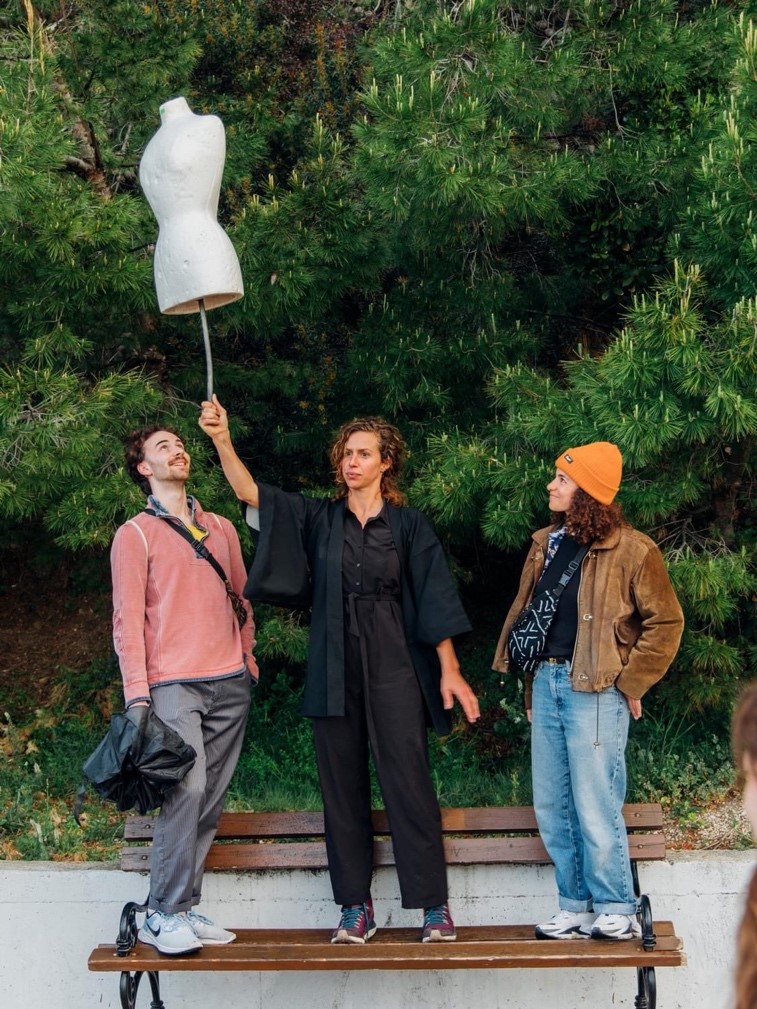
Departure
We started our residency by walking and talking, stating our intentions and needs, sharing our expectations and our goals. Straight away it felt like an open conversation about various topics. We both have ongoing personal artistic processes that we carry with us. That fed our conversation.
Ilon states that her creative processes often start from an analysis of space and context to make well reflected choices. Ward approaches space in an embodied way by physically exploring space through movement and sound. What and why, is a secondary question. We challenge ourselves to incorporate the approach of the other.
Subdivision
A space has both physical and social aspects that make them to what they are. We state that the presence of people has a direct influence on that space. Subcategorising helps us to make conscious choices to reinforce the artistic proposition.
Space:
- Volume (size)
- View (perspectives and backdrops)
- Sound (present and produced)
- Duration (natural or mechanic sequences)
- Architecture (urban planning)
- Location (place)
- History (larger context)
- Utility (public / private / semipublic)
- Character (urban / natural)
- Rules (informal and formal) Personal (empathy and aesthetics)
People (= receivers):
- Passers by
- Settlers
- (Un)informed audience > ‘Accomplices’
- Performer(s)
We made this subdivision during our first three days of exchange. We constructed and challenged the different categories by referring to our own practice and to artworks that have marked us (see reference list below). Even though it was a very effective way to open a wide variety of conversations about performative arts in public space, it also just felt like ‘common sense’ put into an abstract frame. The fourth day we reframed it into variable and fixed elements leading up to the questions “How can I build upon a fixed element? Which variables can be manipulated? Which variables are invasive?”
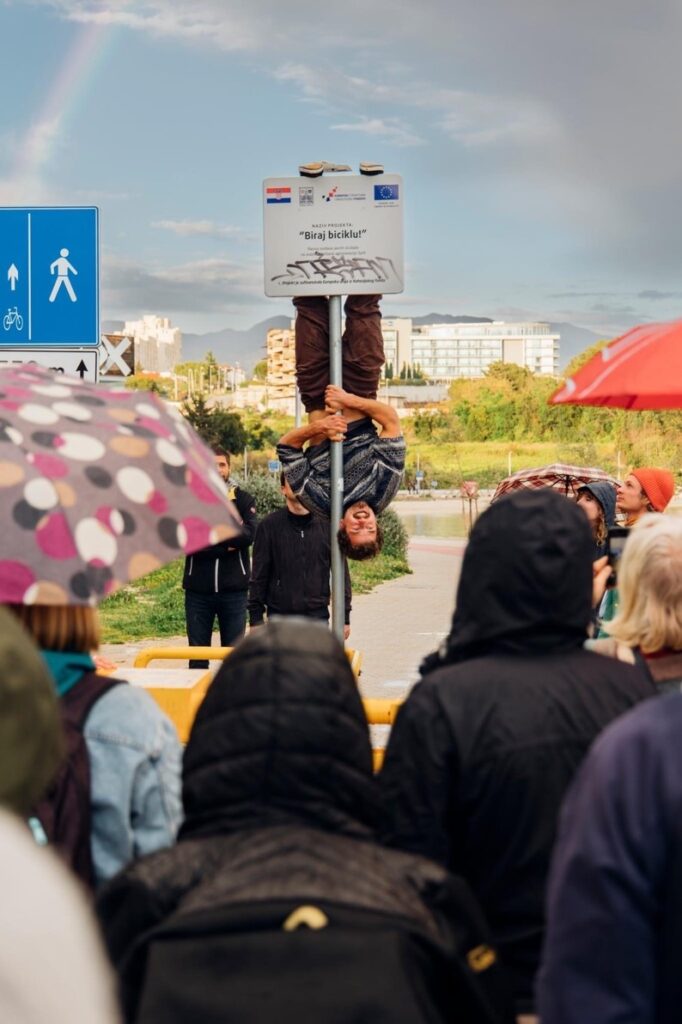
A tool
Rather than claiming Imposing spaces and exposing people to be a methodology, we define it as a personal artistic development tool. It can both be used in a hypothetical and in a practical way.
As artists, we are used to create inside a certain frame (budget, timing, accessibility, …). ISEP is a creative exercise that invites the practitioner to think beyond their own skillset and outside a pre-set frame.
A personal exercise in analysing the potential a (public) space has and the impact a contextualised performative act or installation could possibly have.
Where
We perceive cities as living organisms. Our work is situational, and for that reason strongly related to the here and now. We always act in a larger context. Redefining the use of a space by questioning the norms is what we do. “Is art in public space therefore a marginal happening?”
We walked 104,4 km during our exchange in Split. We experienced the variety between the old city centre, the coastline and the estates of Split 3 (a more residential area build from 1968 to 1982). It made the difference between touristic and living spaces very clear. The seasonable tourism that the city endures is omnipresent. It sets a dynamic that is very peculiar and that can impossibly be ignored while being and creating in Split.
During a tour with our mentor Ivan Svagusa, a visual artist who lives in Split and who is also part of the CWC-program, we remarked many parallels between graffiti (as an illegal street art) and our imposing spaces approach. An artwork changes the space. In its turn, the perception of that artwork changes with the space. This due to variables such as public opinion, urban planning or long-term impact of the weather. This brought us to the questions: “What is the temporality of an artwork in relation to a space?”, “Do we physically need to be in a space to be creative with it?“ and “In which degree do I take in account variable elements when creating an artwork?”
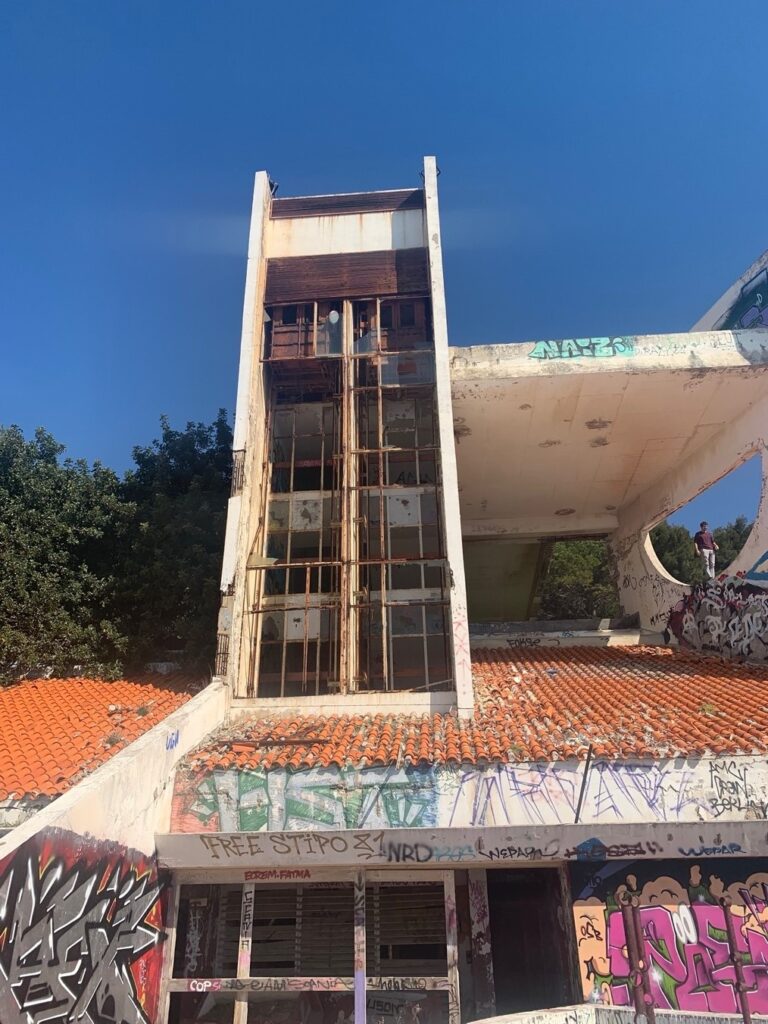
Who
The presence of people has a direct influence on a space. We use the term ‘receiver’ for everyone that shares the space with an artwork. In public space we have passers-by and settlers. These people are in the space with another purpose than culture participation. We also see performer(s) as receivers because they on their turn are also influenced by ‘space and people’. We use the word audience for the people that are informed about the artistic intervention. They can be everything from passive observers to active accomplices.
During one of our field improvisations we felt like intruders that were invading and claiming spaces by using them in unconventional ways. Another field experience brought us to a constellation in which the audience and the passers-by both became protagonists. On both occasions it felt that our interventions were provocative. “Can we make art in public space that doesn’t provoke?”
We have mainly been speaking Dutch together as this is our mother tongue. The word ‘doelpubliek’ (translated: ‘target audience’) resonated a lot. “Who do I target with my artistic proposition?” This question makes the bridge to what we propose and in what way we present it.
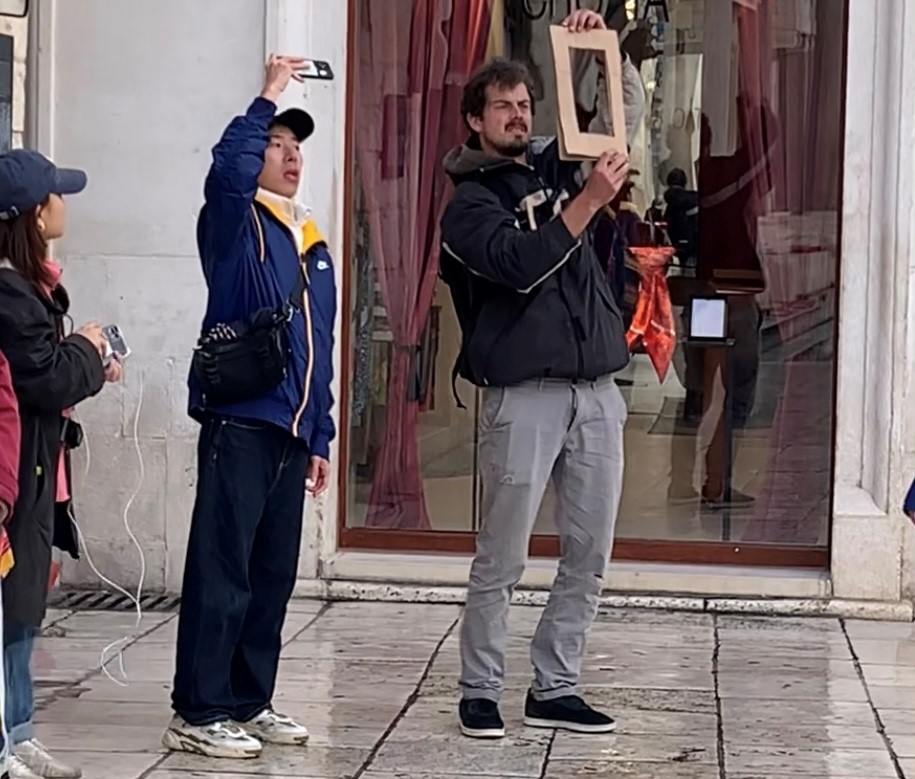
What
ISEP’s reflections and practises occur before the actual conceptualisation and the making process that follows upon. It generates starting points and challenges embryonic ideas by pushing them to extremes in hypothetical ways and on the other hand by putting them into practice with very limited resources.
Which themes does this space carry out and which experience can I offer within?
We have been working on both hypothetical cases and practical exercises. We chose a space and philosophised together how we would start working there if we had to make a production together. We called this the creative thinking exercise. We found it liberating to reflect beyond a pre-set frame. To play with the thought ‘What if there were no constraints’ such as budget, duration, availability, tour ability, accessibility, personal knowhow and local rules. It makes you very aware of the frames you normally are working in; in which degree is it a choice or is it imposed? And in which degree can these constraints be experienced as a source of inspiration or as a suppression?
On other days we chose a space each and gave each other an hour to make an experience for the other one that includes one action and one position of the audience.
We also played with serendipity; we set an alarm and started walking. When the alarm went off we had to discover the space we were at that moment. This exercise plays with the fact that a space can be imposed on you, without a reason or an (emotional) attachment.
During these exercises we have fulfilled multiple roles as researcher, maker, audience, performer, mentor and partner. We offered experiences to each other. Gifts in the form of reflections, performances, references and feedback. It was a very nice experience to shift rolls and to dialogue with someone who has a different approach and practice.
A question that Ilon asked a lot was ‘why would we do that specific thing here’. Ward’s response most often was something like this: “It’s the statement of doing. My creative initiatives disturb daily life. My presence and actions can make the smallest detail visible and offer the receiver other perspectives in a place that for some feel very familiar and very odd to others.”
Ilon: “I often search for a more layered why when I want to create something somewhere. I want to question something somehow. I think Wards point of view on this point is very concrete. Although I still take a critical proposition towards this statement I experienced that it’s also liberating just to start doing something to disturb daily life and maybe a more layered why will arise afterwards or maybe not. And maybe that’s also okay.”
These exercises and points of view brought us to new questions like “What is the norm in this place?”, “Which position does the performance / installation take?”, “To what extent is something specific to this location and what changes when we transpose it to another location?” Many dramaturgic questions arise when adapting a site-responsive idea to another space.
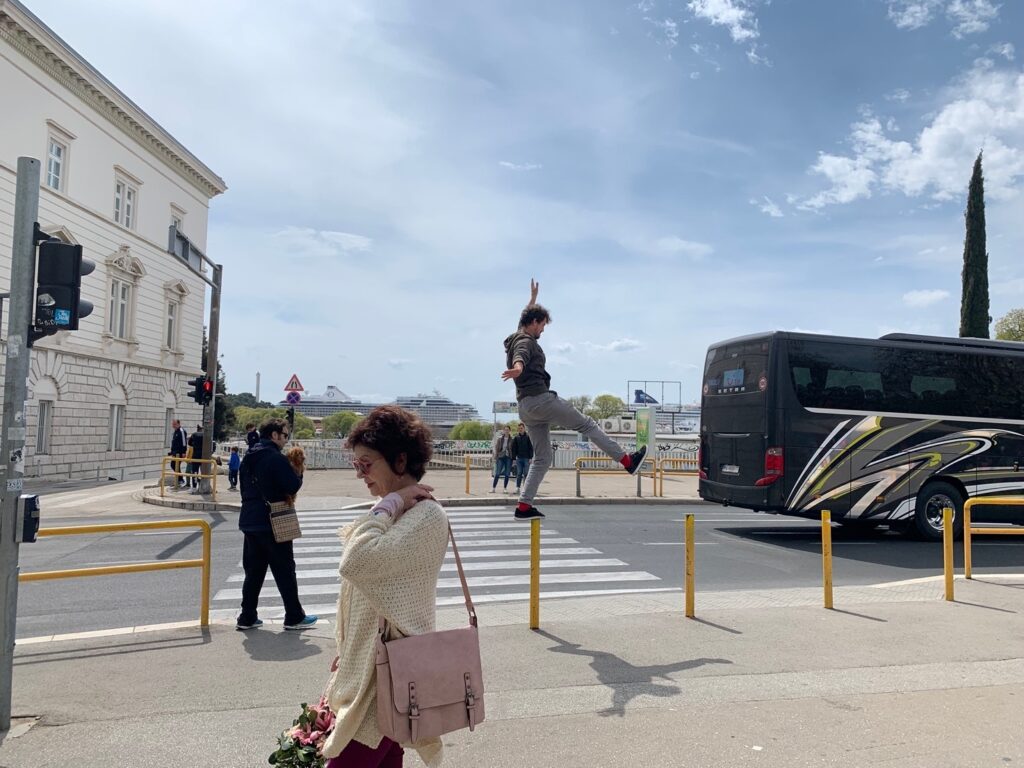
Reflection
Ward: “Both residencies of CWC have been introspective experiences for me. With Be Flat, my circus company, I have mainly been working in duo. Both CWC exchange processes have been very interesting because they were in the same duo format with someone previously unknown. It made me more conscious about my personal approach and how I create and what my strengths/weaknesses are.
I wrote my application in November 2020. I wanted to get surprised, enlarge my communicative skills and open a wider network. When I wrote the application, I knew that my circus practice wasn’t very ‘monodisciplinary’. CWC confirmed the value of cross-disciplinary work. It especially underlined the enormous potential of a diverse group of artists with different backgrounds.
I’ve also noticed that since the start of CWC my definition of circus has changed. CWC offered me a wider view on what circus can be. I learned a lot from both my partners but also from the process of the full CWC project itself.”
Ilon: “The two-week encounter with Ward has been very rewarding for me, both on a personal level and for my practice. The tool we developed trained my sensibility towards site specific work and let me think of circus in new ways.
We talked a lot about our relation to the audience and Ward told me how he interprets the generous act of the traditional circus – I’m coming to your town; I build up a tent and I invite you in my home. I think that’s a beautiful gesture and I never thought about it in that way. Besides that, I think CWC opened my eyes for the democratic statement circus can be, or by history is. Circus has never been for an elite group of people, and it might, in our present time, still be more accessible than something that’s framed as theatre or modern dance. I do embrace the generous anarchistic circus vibe and I’m sure it will stay with me.
During the residence I got, once more, conscious about the fact that I always start creating from my comfort zone; I will automatically avoid what I find scary – in my case, putting myself in the centre as a performer or doing something with an audience without a plan. What can happen if I consciously start from what I find scary?
Just after my residency with Ward I worked on a site, and I realized two differences. 1. I engaged the people I was on the site with immediately, in an embodied way without a plan and 2. At a moment in the creation process where I felt stuck, I asked myself “What would Ward do right now?” I think these realisations were both very funny and a good summary of what kind of effect multidisciplinary residencies can have; you need common ground to find each other, you need to be radical different to get new points of view and you have to be open to let the other person change you.”
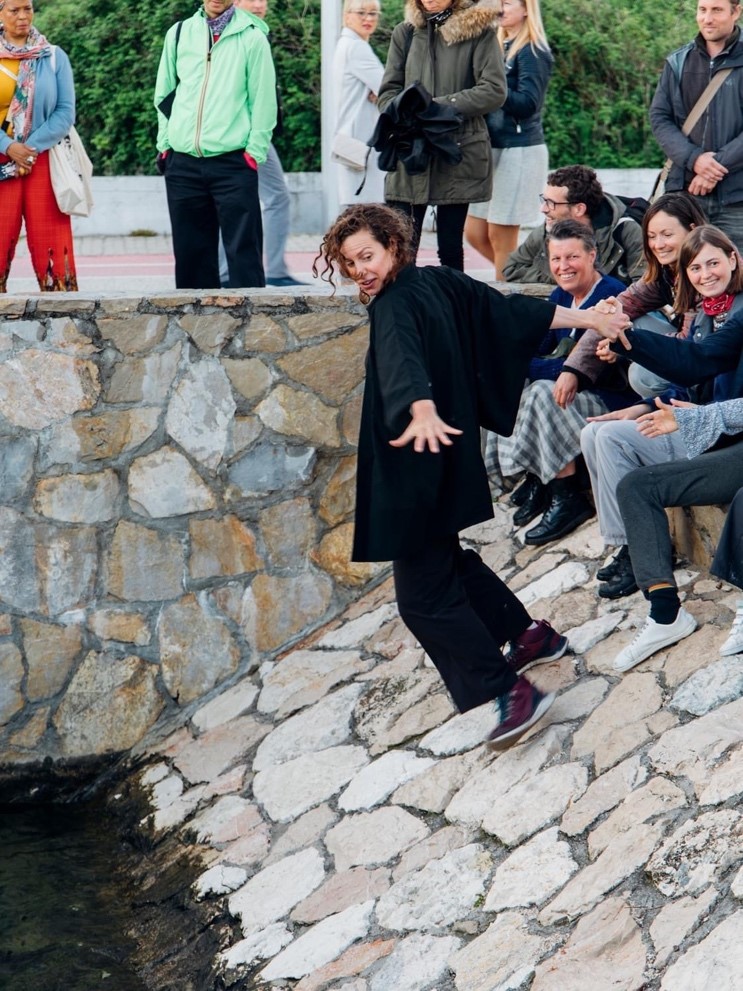
References
- Adelheid Roosen – Wijksafari
- Bad van Marie
- Benjamin Van De Walle – Birdwatching
- Be Flat – Follow Me
- Dries Verhoeven
- Dimitris Papaioannou – Nowhere
- Fragan Gehlker – Le vide
- Grotowski – Poor theatre (method)
- Ilon Lodewijks – TING
- Johannes Bellinckx – Reverse
- Kamchatka – Fugit
- Mardurlier & Deprez – Dieselnation
- Metropolis – Performing landscapes (project)
- Punchdrunk
- Renaud Barret – System K (documentary)
- Roberto Magro – Brocante (festival)
- Sisters hope
- Slew Funk Fury Wit – Foxcave
- Steven Cohen – Coq
- Tino Seghal
- Willie Dorner – Bodies in urban spaces
- Zephyr Brüggen – Woyzeck Zora Snake – Transfrontarlier
Field experiences
- Dancing in touristic place
- Concert of sences in the sea
- Musical in trashed bar
- Installation tent at lifeguard tower
- Walking with timer
- Traffic light rythms
- Analogue framing with tourists